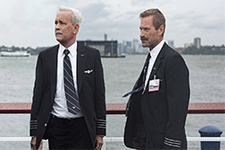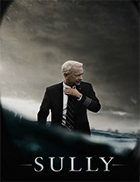Sully
|  In the middle of the afternoon on January 15, 2009, US Airways Flight 1549, which had just taken off from New York’s LaGuardia Airport in route to Charlotte, North Carolina, ran into a flock of Canada geese at 2,800 feet, which caused both engines to fail. Captain Chesley “Sully” Sullenberger and First Officer Jeff Skiles managed to land the plane on the Hudson River, saving all 155 passengers and crew members, an amazing feat that quickly came to be known as “The Miracle on the Hudson.” For days the media were awash in images of the partially submerged airbus in the middle of the frigid North River with passengers climbing out and being rescued by nearby watercraft. Sully, a 40-year veteran of both military and commercial aviation, became an instant hero, appearing on numerous television shows, his sense of bravery and commitment bested only by his down-to-earth persona and humility (“I don’t feel like a hero,” he tells Katie Couric in one of his numerous interviews). In the middle of the afternoon on January 15, 2009, US Airways Flight 1549, which had just taken off from New York’s LaGuardia Airport in route to Charlotte, North Carolina, ran into a flock of Canada geese at 2,800 feet, which caused both engines to fail. Captain Chesley “Sully” Sullenberger and First Officer Jeff Skiles managed to land the plane on the Hudson River, saving all 155 passengers and crew members, an amazing feat that quickly came to be known as “The Miracle on the Hudson.” For days the media were awash in images of the partially submerged airbus in the middle of the frigid North River with passengers climbing out and being rescued by nearby watercraft. Sully, a 40-year veteran of both military and commercial aviation, became an instant hero, appearing on numerous television shows, his sense of bravery and commitment bested only by his down-to-earth persona and humility (“I don’t feel like a hero,” he tells Katie Couric in one of his numerous interviews).Clint Eastwood’s new film Sully purports to show us what most of us didn’t know at the time: that this savior-hero who seemed so unassailable on The Tonight Show and on the front pages of every newspaper was being grilled behind the scenes by insurance adjustors and investigators from the National Transportation Safety Board (NTSB) about his decision to land the plane on the river rather than bring it back to LaGuardia or a nearby airport in New Jersey, which they claim he could have done (while there was a thorough investigation, the antagonism of the NTSB as depicted in the film is exaggerated, if not largely fictional). Sully was insistent that there was no way he could have gotten the plane to a runway with both engines completely stalled out, and a “forced water landing” was the only possible option. Of course, that decision carried with it a great deal of risk, as a water landing of that type usually results in casualties, but Sully managed to do it without losing a single soul on board (and, while there were injuries, there were only two serious enough to require overnight hospitalization). The behind-the-scenes investigation and the conflict between Sully’s public image as an unassailable hero and the attempts by investigators to blame him for the loss of the airplane, is the subject Sully, which fits neatly into Eastwood’s decade-long cinematic foray into recent history, which includes his twin World War II dramas Flags of Our Fathers (2006) and Letters From Iwo Jima (2006), the Depression-era mystery Changeling (2008), the South African soccer drama Invictus (2009), and the controversial biopics J. Edgar (2011) and American Sniper (2014). Screenwriter Todd Komarnicki (Perfect Stranger), working from Sully’s 2010 memoir Highest Duty: My Search for What Really Matters, scatters the depiction of the infamous flight and its forced landing throughout the film and presents parts of it multiple times from different perspectives (first from the passengers’ experience and then from Sully and Jeff’s viewpoint in the cockpit). Added into that are several nightmare sequences, including one that opens the film, in which Sully dreams that the plane, rather than landing safely in the water, crashes into a building in downtown New York, a nightmarish image that unavoidably invokes the horrors of 9/11. Tom Hanks and Aaron Eckhart as both excellent as Sully and Jeff, and part of the reason the film works as well as it does is because they have a natural chemistry that makes their partnership both before and after the Hudson landing feel real and lived-in. Sully is a man of inherent, fundamental decency, which Hanks has always excelled at playing, while Jeff is a little rougher around the edges, but still decidedly likeable in tone and action (it is not insignificant that Jeff gets to end the film on a zinger). Sully’s best sequence is the depiction of those 208 seconds in the cockpit after they realize that both engines have failed, try to determine the best course of action, and then enact it. They both remain calm and steady, portraits of steely professionalism that remains unwavering even in the face of catastrophe. Both Hanks and Eckhart make their characters’ underlying fear palpable, but always checked by their resolve and their instincts to do everything they can to survive. Eastwood has always been a great actor’s director, having been an actor himself for 15 years before first stepping foot behind the camera back in 1971, which is why the film continues working even when there is little to do but wait. There are numerous scenes of Sully on the phone with his wife, Lorrie (Laura Linney), who is literally trapped at home by all the media vans and feeling overwhelmed by the sudden attention and fame (there are also some intimations of stress at home and financial problems, but nothing that would actually sully Sully). These scenes tend to drag a bit, even as they help to further humanize Sully and dramatize the downside of his sudden, unrequested worldwide fame, and they are saved largely by Hanks and Linney creating a genuine rapport between a husband and wife whose only connection during the most stressful time of their lives is a telephone line. If Sully has a real problem, it is the climactic public hearing that caps the investigation into Sully’s decision making (to increase the drama and tension, the film compresses an investigation that took nearly a year and a half into what appears to be a couple of days). The humorless and seemingly vindictive investigators are resolute that Sully made the wrong decision and should be held accountable for wrecking an airplane and needlessly jeopardizing lives, and they appear to have the evidence to prove it (if found at fault, he would lose not just his respectability and job, but also his long-earned pension). Sully, on the other hand, is sure that he did the right thing, not because he has hard evidence on hand, but because he has four decades of experience that have honed his instincts to a razor sharp edge; he had his gut, and as the film puts it, a professional’s gut instinct is superior to algorithms and multi-step flight plans. It all comes down to several flight simulations that either will or won’t justify Sully’s water landing, which generates significant suspense even if you know the outcome. Unfortunately, a film that has already been almost uniformly hagiographic in the treatment of its subject goes over the top in its final moments, giving otherwise antagonistic characters a sudden and phony-feeling change of heart that is all about audience-pleasing uplift, but flies in the face of the rest of the film’s focus on the difficulties involved in being hailed a hero. It’s not enough to sink Sully, but it does provide a too-neat coda that leaves a sour taste of manipulation in the final moments—an ill-fitting end to an otherwise strong film. Copyright ©2016 James Kendrick Thoughts? E-mail James Kendrick All images copyright © Warner Bros. |
Overall Rating: 

 (3)
(3)


